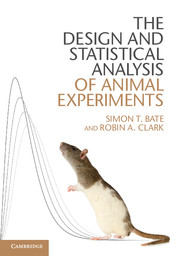Crossref Citations
This Book has been
cited by the following publications. This list is generated based on data provided by Crossref.
Bate, Simon
Karp, Natasha A.
and
Peddada, Shyamal D.
2014.
A Common Control Group - Optimising the Experiment Design to Maximise Sensitivity.
PLoS ONE,
Vol. 9,
Issue. 12,
p.
e114872.
Hawkins, Penny
Armstrong, Rachel
Boden, Tania
Garside, Paul
Knight, Katherine
Lilley, Elliot
Seed, Michael
Wilkinson, Michael
and
Williams, Richard O.
2015.
Applying refinement to the use of mice and rats in rheumatoid arthritis research.
Inflammopharmacology,
Vol. 23,
Issue. 4,
p.
131.
Golizeh, Makan
LeBlanc, André
and
Sleno, Lekha
2015.
Identification of Acetaminophen Adducts of Rat Liver Microsomal Proteins using 2D-LC-MS/MS.
Chemical Research in Toxicology,
Vol. 28,
Issue. 11,
p.
2142.
Bate, Simon T.
and
Chatfield, Marion J.
2016.
Identifying the Structure of the Experimental Design.
Journal of Quality Technology,
Vol. 48,
Issue. 4,
p.
343.
Bains, Rasneer S.
Cater, Heather L.
Sillito, Rowland R.
Chartsias, Agisilaos
Sneddon, Duncan
Concas, Danilo
Keskivali-Bond, Piia
Lukins, Timothy C.
Wells, Sara
Acevedo Arozena, Abraham
Nolan, Patrick M.
and
Armstrong, J. Douglas
2016.
Analysis of Individual Mouse Activity in Group Housed Animals of Different Inbred Strains using a Novel Automated Home Cage Analysis System.
Frontiers in Behavioral Neuroscience,
Vol. 10,
Issue. ,
2016.
Biology and Ecology of Crayfish.
p.
335.
Pillidge, Katharine
Heal, David J
and
Stanford, S Clare
2016.
The NK1R-/- mouse phenotype suggests that small body size, with a sex- and diet-dependent excess in body mass and fat, are physical biomarkers for a human endophenotype with vulnerability to attention deficit hyperactivity disorder.
Journal of Psychopharmacology,
Vol. 30,
Issue. 9,
p.
848.
Bertrand, Henri G. M. J.
Ellen, Yvette C.
O’Keefe, Stevie
and
Flecknell, Paul A.
2016.
Comparison of the effects of ketamine and fentanyl-midazolam-medetomidine for sedation of rhesus macaques (Macaca mulatta).
BMC Veterinary Research,
Vol. 12,
Issue. 1,
Ding, Ying
and
Lin, Hui-Min
2016.
In Vivo Fluorescence Imaging.
Vol. 1444,
Issue. ,
p.
193.
Reutovich, M. Yu.
Istomin, Yu. P.
Krasko, O. V.
Treshalina, H. M.
Bychkovsky, P. M.
Yurkshtovich, T. L.
Shmak, A. I.
Golub, N. V.
Alinovskaya, V. A.
Kosterova, R. I.
Solomevich, S. O.
and
Rogov, Y. I.
2016.
ANTITUMOR EFFECT OF HYDROGEL CISPLATIN ON ZEJDEL ASCITES HEPATOMA.
Russian Journal of Biotherapy,
Vol. 15,
Issue. 4,
p.
96.
Demirkale, Fatih
Donovan, Diane
Hall, Joanne
Khodkar, Abdollah
and
Rao, Asha
2016.
Difference Covering Arrays and Pseudo-Orthogonal Latin Squares.
Graphs and Combinatorics,
Vol. 32,
Issue. 4,
p.
1353.
Caballero-Puntiverio, Maitane
Fitzpatrick, Ciarán Martin
Woldbye, David PD
and
Andreasen, Jesper Tobias
2017.
Effects of amphetamine and methylphenidate on attentional performance and impulsivity in the mouse 5-Choice Serial Reaction Time Task.
Journal of Psychopharmacology,
Vol. 31,
Issue. 2,
p.
272.
Fitzpatrick, C. M.
Caballero-Puntiverio, M.
Gether, U.
Habekost, T.
Bundesen, C.
Vangkilde, S.
Woldbye, D. P. D.
Andreasen, J. T.
and
Petersen, A.
2017.
Theory of Visual Attention (TVA) applied to mice in the 5-choice serial reaction time task.
Psychopharmacology,
Vol. 234,
Issue. 5,
p.
845.
Bate, Simon T
Clark, Robin A
and
Stanford, S Clare
2017.
Using InVivoStat to perform the statistical analysis of experiments.
Journal of Psychopharmacology,
Vol. 31,
Issue. 6,
p.
644.
Reutovich, M. Yu.
Istomin, Yu. P.
Krasko, O. V.
Treshalina, H. M.
Shmak, A. I.
Bychkovsky, P. M.
Yurkshtovich, T. L.
Golub, N. V.
Solomevich, S. O.
and
Rogov, Y. I.
2017.
Value of rationality cisplatin addition into prospidin hydrogel for intraperitoneal chemotherapy of Zajdel hepatoma.
Russian Journal of Biotherapy,
Vol. 16,
Issue. 2,
p.
30.
Kirkham, Amy A.
Eves, Neil D.
Shave, Rob E.
Bland, Kelcey A.
Bovard, Joshua
Gelmon, Karen A.
Virani, Sean A.
McKenzie, Don C.
Stöhr, Eric J.
Waburton, Darren E. R.
and
Campbell, Kristin L.
2018.
The effect of an aerobic exercise bout 24 h prior to each doxorubicin treatment for breast cancer on markers of cardiotoxicity and treatment symptoms: a RCT.
Breast Cancer Research and Treatment,
Vol. 167,
Issue. 3,
p.
719.
Jeffery, Nick D.
Bate, Simon T.
Safayi, Sina
Howard, Matthew A.
Moon, Lawrence
and
Jeffery, Unity
2018.
When neuroscience met clinical pathology: partitioning experimental variation to aid data interpretation in neuroscience.
European Journal of Neuroscience,
Vol. 47,
Issue. 5,
p.
371.
Abd-El-Haliem, Ahmed M.
Hoogstrate, Suzanne W.
and
Schuurink, Robert C.
2018.
A Robust Functional Genomics Approach to Identify Effector Genes Required for Thrips (Frankliniella occidentalis) Reproductive Performance on Tomato Leaf Discs.
Frontiers in Plant Science,
Vol. 9,
Issue. ,
Than-Trong, Emmanuel
Ortica-Gatti, Sara
Mella, Sébastien
Nepal, Chirag
Alunni, Alessandro
and
Bally-Cuif, Laure
2018.
Neural stem cell quiescence and stemness are molecularly distinct outputs of the Notch3 signalling cascade in the vertebrate adult brain.
Development,
Vol. 145,
Issue. 10,
Odland, Anna U.
Jessen, Lea
Fitzpatrick, Ciarán M.
and
Andreasen, Jesper T.
2019.
8-OH-DPAT Induces Compulsive-like Deficit in Spontaneous Alternation Behavior: Reversal by MDMA but Not Citalopram.
ACS Chemical Neuroscience,
Vol. 10,
Issue. 7,
p.
3094.



